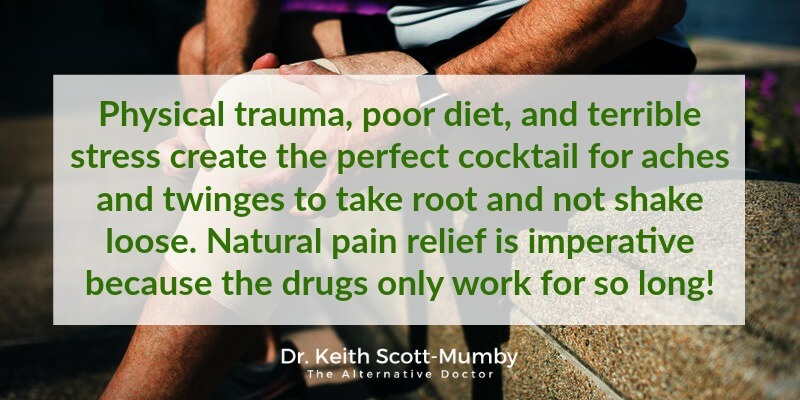Chronic pain is the bane of modern mankind. Physical trauma, habitual overwork, lack of adequate sleep, poor diet, and terrible stress create the perfect cocktail for all sorts of aches and twinges to take root and not shake loose. Finding natural chronic pain relief is imperative because the drugs only work for so long (and come with horrible side effects)!
There’s a better way. There usually is but they aren’t discussed in mainstream media, the medical community, or government agencies who are supposed to have your best interests at heart (and do not).
What is Chronic Pain?
Pain is a signal sent by your central nervous system that something isn’t right. It can be a prick, tingle, sting, burn, or ache. It may be sharp or dull. You might feel it in one area or all over.
Because “pain” (both the cause and how it manifests) can be so different for each individual – it can make it difficult to diagnose or treat with the same outcomes for every patient. Just as every pain is unique, what works as chronic pain relief may vary from one person to another.
The World Health Organization (WHO) broadened the definition of chronic pain to expand and improve treatment options and improve patient quality of life. They called for chronic pain to be classified as a disease. If you suffer from chronic pain – or know someone who does – then you know how difficult it is to diagnose, treat, and explain to others who don’t understand.
During the Global Day Against Pain men and women from agencies and universities around the world weighed in on a topic that is long overdue. Rolf-Detlef Treede with Heidelberg University in Germany and part of the International Association on the Study of Pain (IASP) explained, “This will have major implications for health care. We should see chronic pain finally getting the recognition it deserves.”
“Chronic pain has for years been poorly understood and poorly treated. The WHO recognising chronic primary pain should reverse this trend and improve the lives of patients around the world,” stated Liisa Jutila, Vice President of Pain Alliance Europe.
“Chronic pain is one of the most underestimated health care problems in the world today, causing major consequences for the quality of life of the sufferer and a major burden on the health care system in the Western world. The consequences of unrelieved pain are great,” said Professor Harald Breivik, President of European Federation of the IASP Chapters (EFIC).
WHO estimates that one-in-five people globally suffer from chronic pain. It is definitely time to find real, effective, and safe chronic pain relief!
Acute pain lets you know that you are injured or a have problem. This type of pain subsides when the injury or problem is resolved. While uncomfortable, it is typically temporary.
Chronic pain may last for weeks, months, or even years. The original source could be injury, infection, chronic condition (such as arthritis), or disease (such as cancer). Lifestyle habits, your environment, and even your mental health can have an impact on severity and treatment.
What many people don’t realize is that some pain has no clear cause.

Acupuncture – An Ancient Solution to a Modern Problem
Acupuncture is an ancient Chinese treatment. Its’ earliest known use is recorded as far back as 200 BC. It wasn’t really known in the Western world until the 1970s.
The practice involves inserting thin needles along meridians that are close to the surface of your skin. It naturally corrects imbalances in the natural energy pathways of the body that become blocked. When these pathways aren’t open or balanced, your risk of disease is higher.
Before you outright dismiss acupuncture, know that scientists all over the world praise its’ effectiveness for many uses (one of them being chronic pain relief). However, they can’t really explain how or why it works. Typically, when they can’t explain something, it gets buried. We see this with many natural remedies and treatment modalities!
In 1997, acupuncture was formally recognized by the U.S. National Institutes of Health (NIH) as a safe and efficient natural pain relief option with rare possibility of side effect.
NIH recently released a study in the Archives of Internal Medicine spanning more than five years about the effectiveness of acupuncture as a migraine treatment. The long-term study followed more than 18,000 patient participants and the results were clear!
Acupuncture performed above and beyond traditional medications to naturally manage migraine pain, chronic back and neck pain, and osteoarthritis! Acupuncture is no longer “controversial.” It is among the most widely practiced forms of alternative medicine in the world and is even offered by many hospitals globally!
Acupuncture is used as an adjunct or alternative treatment for addiction, stroke, headache, menstrual cramps, tennis elbow, fibromyalgia, osteoarthritis, low back pain, carpal tunnel syndrome, asthma, infertility, pregnancy problems, dental pain, side effects from cancer treatment, and much more.
One advantage of this type of treatment, admits NIH, is that the side effects are substantially lower than that of many drugs or other accepted medical procedures used for chronic pain relief.
If you suffer from any condition that includes pain that never ends, I strongly suggest you consider acupuncture in combination with other pain management techniques. There are other methods of treating pain that are as natural (and effective) as acupuncture.
Some of these include…
- Electrical stimulation
- Physical therapy
- Psychotherapy
- Relaxation and meditation therapy
- Biofeedback
I talk about many of these methods (and more) in my book The Ultimate Guide to Natural Pain Relief. If pain is a constant (and unwelcome) visitor in your life, you need to read this book!
Chronic pain relief is possible and you deserve to live pain-free.
The post Using Acupuncture for Chronic Pain Relief appeared first on Dr. Keith Scott-Mumby.
